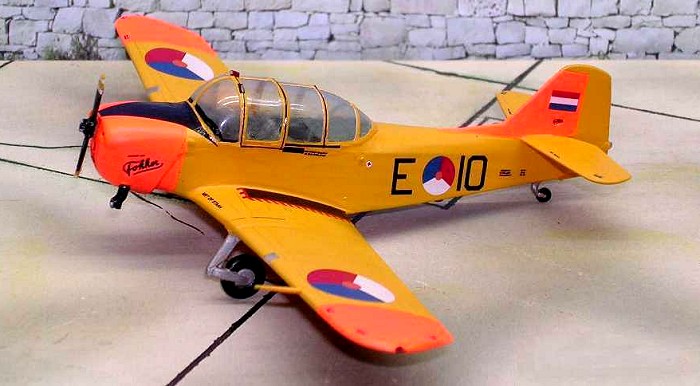
CMR 1/72 Fokker S-11/T-22 Instructor
| KIT #: | CMR 047 |
| PRICE: | $ |
| DECALS: | Six options |
| REVIEWER: | Carmel J Attard |
| NOTES: | Resin kit with vac canopy |

| HISTORY |
The 1/72 scale Resin kit of the Fokker Instructor by Czech Master Resin (CMR) represents any one of the versions evolving from the S-11, that is one can build any one of the following versions: S-11, S-12 or T-22.
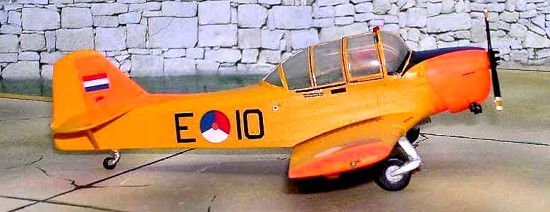 The Fokker S-11
Instructor is a simple two-seat primary trainer produced in the
Netherlands. The first series of 40 was built for the Royal Netherlands Air
Force. In the early 50s the Fokker Company also supplied 41 to the Israeli
Defence Force Air Force. Macchi also produced the S-11 under license in
Italy under the designation M416. 150 were delivered to the Italian Air
Force. In 1954 Fokker company established an associate company in Brazil,
which produced 100 S-11s and 70 S-12/T-22s. The latter differed only in
having a tricycle undercarriage. In 1979 these were known to be still in
active service. The Instructor was powered by a 190 HP Lycoming 0-435A
engine, which gave a maximum speed of 130 mph and a range of 400 miles.
The Fokker S-11
Instructor is a simple two-seat primary trainer produced in the
Netherlands. The first series of 40 was built for the Royal Netherlands Air
Force. In the early 50s the Fokker Company also supplied 41 to the Israeli
Defence Force Air Force. Macchi also produced the S-11 under license in
Italy under the designation M416. 150 were delivered to the Italian Air
Force. In 1954 Fokker company established an associate company in Brazil,
which produced 100 S-11s and 70 S-12/T-22s. The latter differed only in
having a tricycle undercarriage. In 1979 these were known to be still in
active service. The Instructor was powered by a 190 HP Lycoming 0-435A
engine, which gave a maximum speed of 130 mph and a range of 400 miles.
| THE KIT |
 The kit comes in a
The kit comes in a polythene bag, which contains all the resin components, a vac form cockpit
and a comprehensive decal sheet of high quality as well as several sheets
of drawings and pictures to assist making a god replica of the Fokker
versions. There is no history included in the instruction sheet normally
accompanying scale models but there are included five double sided pages
with clear illustrations, close-up pictures which are clear and more than
sufficient to detail the kit at the scale of 1/72. These also include two
pages with 5 view drawings, which give the exact colour detail for any one
chosen from the Dutch, Israeli and Brazilian machines. The close-up
picture shows the level of detail provided by the kit.
polythene bag, which contains all the resin components, a vac form cockpit
and a comprehensive decal sheet of high quality as well as several sheets
of drawings and pictures to assist making a god replica of the Fokker
versions. There is no history included in the instruction sheet normally
accompanying scale models but there are included five double sided pages
with clear illustrations, close-up pictures which are clear and more than
sufficient to detail the kit at the scale of 1/72. These also include two
pages with 5 view drawings, which give the exact colour detail for any one
chosen from the Dutch, Israeli and Brazilian machines. The close-up
picture shows the level of detail provided by the kit.
| CONSTRUCTION |
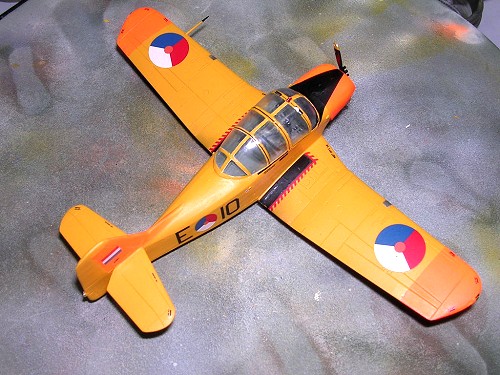 The resin fuselage is
moulded in two halves, which include the vertical tail surfaces, and there
is an appreciable amount of detail cast to each side of the cockpit
interior. The cockpit walls are of virtually scale thickness that can make
for a realistic model in the open cockpit machines. Ones the components are
carefully removed from the feeder core all that is needed is a little
cleaning up along the bottom surfaces each of which matches perfectly when
the two halves are placed together. There are four main wing parts, a pair
to go with each version supplied so that one will have to decide at an
earlier stage the type intending to build. One set of wings slightly differ from the other set in having chordwise wing stiffeners
embossed on the upper wing surface. The leading edge of each wing has slots
to take the clear parts to make the landing light, for which clear parts of
correct size are also provided. All of the main components contain very
fine grooved panel lines. As common with other resin kits there are no grab
holes or slots at the wing root joints and one will have to refer to the
front elevation drawing depicted on page 4 in order to align the wings
correctly. One may remark that in my sample the slightly gull shape on the
wings slightly differed from each other. This required surgery using the
Xacto blade to cut the wing in two sections and join again carefully
obtaining the correct wing angles. The pitot tube which is fitted to the
leading edge of the port wing differed from one version to another. Careful
study indicated that the version I did had a straight one. This I shaped to
the correct size out of a steel pin, which I fitted inside a pre-drilled
hole of the correct size.
The resin fuselage is
moulded in two halves, which include the vertical tail surfaces, and there
is an appreciable amount of detail cast to each side of the cockpit
interior. The cockpit walls are of virtually scale thickness that can make
for a realistic model in the open cockpit machines. Ones the components are
carefully removed from the feeder core all that is needed is a little
cleaning up along the bottom surfaces each of which matches perfectly when
the two halves are placed together. There are four main wing parts, a pair
to go with each version supplied so that one will have to decide at an
earlier stage the type intending to build. One set of wings slightly differ from the other set in having chordwise wing stiffeners
embossed on the upper wing surface. The leading edge of each wing has slots
to take the clear parts to make the landing light, for which clear parts of
correct size are also provided. All of the main components contain very
fine grooved panel lines. As common with other resin kits there are no grab
holes or slots at the wing root joints and one will have to refer to the
front elevation drawing depicted on page 4 in order to align the wings
correctly. One may remark that in my sample the slightly gull shape on the
wings slightly differed from each other. This required surgery using the
Xacto blade to cut the wing in two sections and join again carefully
obtaining the correct wing angles. The pitot tube which is fitted to the
leading edge of the port wing differed from one version to another. Careful
study indicated that the version I did had a straight one. This I shaped to
the correct size out of a steel pin, which I fitted inside a pre-drilled
hole of the correct size.
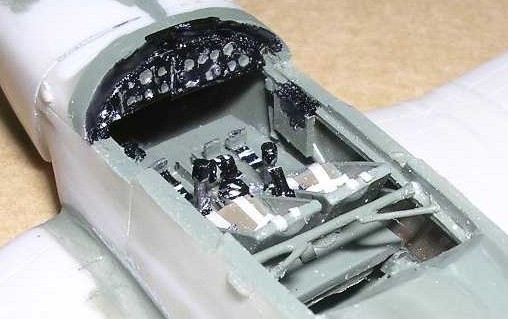 The cockpit floor is
neatly cast with rudder pedals, central console and two control sticks
integrated in one piece. A detailed instrument panel, two crew seats and
other supporting brackets fitted to the rear of the seats all come in
separate parts, some of which are accurately very thin in section but which
are delicate to handle. Careful paintwork to the instrument panel and seat
harness will not be lost as the cockpit canopy comes in one piece made out
of acetate. The tail planes come in two parts with separate supporting
struts. There are also four tiny balance weights to fit to the ailerons and
elevator areas. Again I preferred to drill a hole of 0.4mm diameter to
secure these in the correct emplacement. Two slightly different resin
propellers come with the kit, one of which has a nose cone and finally one
will have to select the type of exhaust pipes to go with the model being
made as several are provided and each version had its ow3n shape and design
of exhaust pipe. The S-11 had a tail wheel while the T-22, which is the
Brazil version had tricycle undercarriage and again the manufacturer
provided alternative sets of undercarriage consisting of three wheel
assemblies with each set.
The cockpit floor is
neatly cast with rudder pedals, central console and two control sticks
integrated in one piece. A detailed instrument panel, two crew seats and
other supporting brackets fitted to the rear of the seats all come in
separate parts, some of which are accurately very thin in section but which
are delicate to handle. Careful paintwork to the instrument panel and seat
harness will not be lost as the cockpit canopy comes in one piece made out
of acetate. The tail planes come in two parts with separate supporting
struts. There are also four tiny balance weights to fit to the ailerons and
elevator areas. Again I preferred to drill a hole of 0.4mm diameter to
secure these in the correct emplacement. Two slightly different resin
propellers come with the kit, one of which has a nose cone and finally one
will have to select the type of exhaust pipes to go with the model being
made as several are provided and each version had its ow3n shape and design
of exhaust pipe. The S-11 had a tail wheel while the T-22, which is the
Brazil version had tricycle undercarriage and again the manufacturer
provided alternative sets of undercarriage consisting of three wheel
assemblies with each set.
| COLORS & MARKINGS |
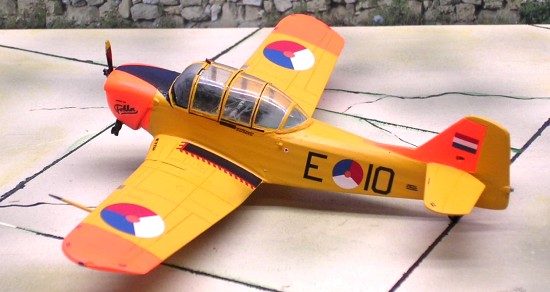 The Fokker Instructor
is a colourful aircraft whatever scheme you select from the ones supplied
and in the end the 32 resin pieces and three clear parts can turn it into a
colourful gem. So one will have to think twice before deciding which scheme
to choose fro the three provided. To assist in this there are two colour
side view drawings depicting a Brazilian and a Dutch aircraft. The scheme I
chose was the Dutch one, which carried several areas in day, glow orange on
an otherwise overall trainer yellow. Careful masking with masking tape and
maskol produced clean colour separation as shown in the pictures. Having
completed the general paintwork of the aircraft I then turned to detailing
the cockpit area, adding hand grips to the sliding section of the canopy,
wing walkways, antiglare panel etc. using solely the sheets of drawings
provided with the kit which provided wealth of detail reference. The decals
sheet also provided all the national insignias with the correct
registration and good adhesion properties.
The Fokker Instructor
is a colourful aircraft whatever scheme you select from the ones supplied
and in the end the 32 resin pieces and three clear parts can turn it into a
colourful gem. So one will have to think twice before deciding which scheme
to choose fro the three provided. To assist in this there are two colour
side view drawings depicting a Brazilian and a Dutch aircraft. The scheme I
chose was the Dutch one, which carried several areas in day, glow orange on
an otherwise overall trainer yellow. Careful masking with masking tape and
maskol produced clean colour separation as shown in the pictures. Having
completed the general paintwork of the aircraft I then turned to detailing
the cockpit area, adding hand grips to the sliding section of the canopy,
wing walkways, antiglare panel etc. using solely the sheets of drawings
provided with the kit which provided wealth of detail reference. The decals
sheet also provided all the national insignias with the correct
registration and good adhesion properties.
| CONCLUSIONS |
All in all this was a pleasing model to build but certainly not for the novice modeller.
August 2005
Copyright ModelingMadness.com. All rights reserved. No reproduction in part or in whole without express permission from the editor.
If you would like your product reviewed fairly and quickly, please contact the editor or see other details in the Note to Contributors.